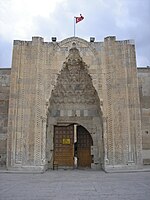Kayqubadiyya Palace
Kayqubadiyya, was a palace built by the Seljuk Sultan of Rum, Kayqubad I, between 1224 and 1226.[1] Located northwest of Kayseri, the place is now called Kiybad Ciftligi and sits near the plain of Mashhad.[2] As a place to review the troops, the road, which proceeds past the palace, has been in use since pre-Roman times.[2]
The palace was the favorite residence of Kayqubad I, and it was here that he received the capitulation of Malik al-Din Dawudshah, lord of Erzincan.[2] In 1237, Kayqubad was holding a banquet at Kayqubadiyya, where he was poisoned and subsequently died.[2][3] His son, Kaykhusraw II would ascend the throne at Kayqubadiyya,[2] following the execution of his brothers, Rukn al-Din and Kilic Arslan.[3]
The palace was just one of many architectural foundations and monuments whose construction was initiated by Kayqubad I.[2] The site was excavated in 1964.[2]
References[edit]
- ^ Lambton & Lewis 1977, p. 248.
- ^ a b c d e f g Busse 1997, p. 818.
- ^ a b Eastmond 2017, p. 197.
Sources[edit]
- Busse, H. (1997). "Kaykubadiyya". In Van Donzel, E.; Lewis, B.; Pellat, Ch. (eds.). The Encyclopaedia of Islam. Vol. IV. Brill. p. 818. ISBN 978-90-04-08114-7.
- Eastmond, Antony (2017). Tamta's World. Cambridge University Press. p. 197. ISBN 978-11-07-16756-8. Retrieved 15 August 2020.
- Lambton, Ann K.S.; Lewis, Bernard (1977). The Cambridge History of Islam: The Central Islamic lands since 1918. Vol. 1B. Cambridge University Press. p. 248. ISBN 978-052-129-135-4. Retrieved 19 August 2020.

